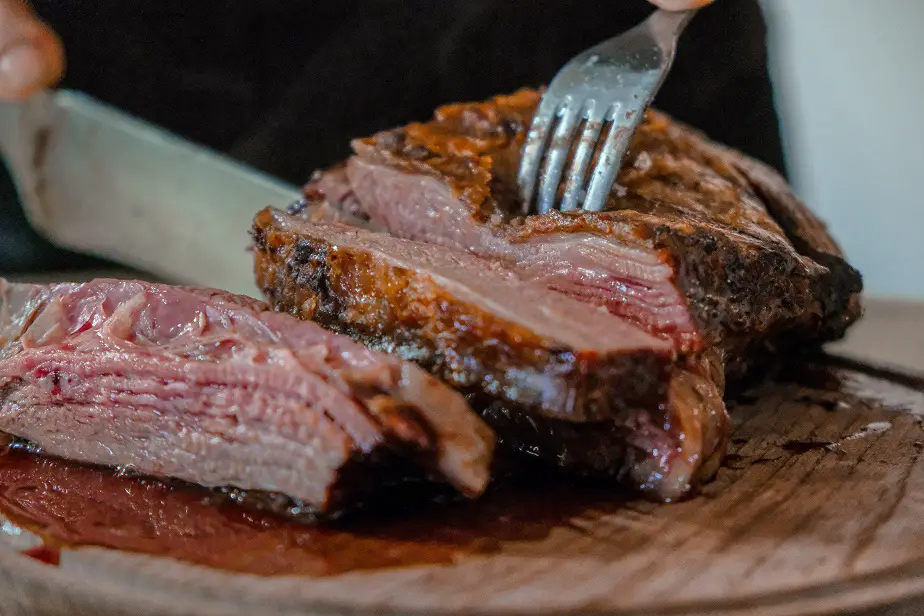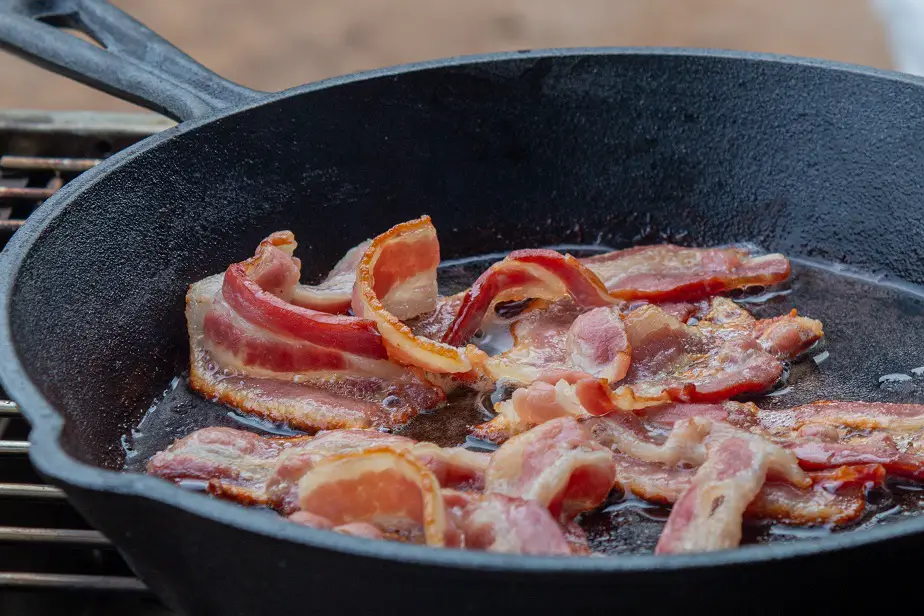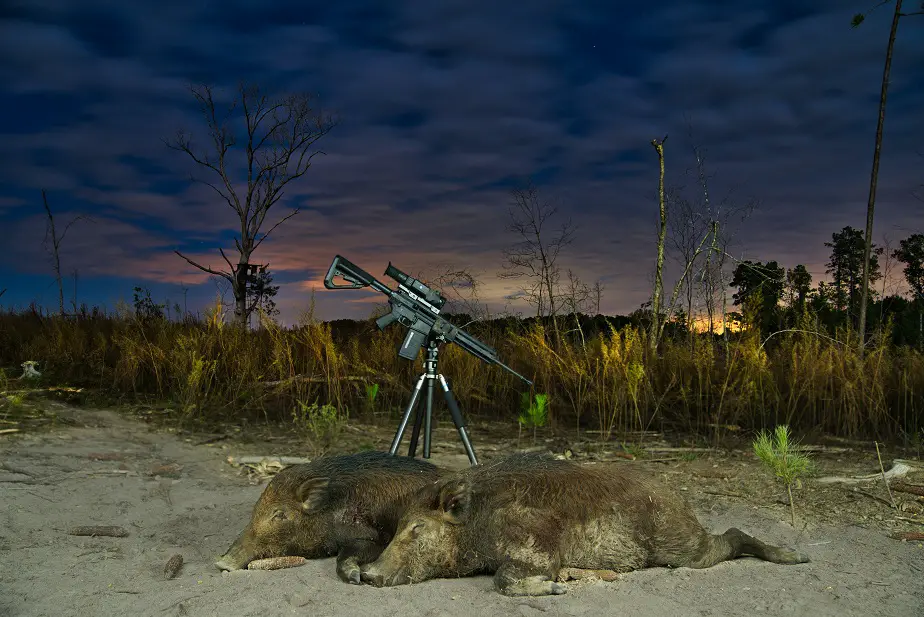Hog hunting is fun, but is the meat any good? It’s my favorite game meat and I can’t wait for more.
Wild hog meat is perfect for human consumption. It is a delicious source of organic pork. The flavor and texture are that of pasture-raised heritage breed pork. Wild hog is a leaner, more flavorful, and darker meat than commercial pork, and needs to be cooked slower to keep it from becoming tough. Marinating it overnight also helps.
It’s not quite like pork from the grocery store. Wild pork has some safety concerns and needs to be cooked right to be really tasty.

Do Wild Hogs Taste Good?
Most wild hogs taste great. Improper cooking and handling can lead to a bad flavor. Wild hogs have stronger favored meat, darker meat than store-bought pork. Most hunters enjoy the flavor of wild pork and prefer the meat of younger wild hogs.
The average hog tastes pretty good. A lot like pork you are used to, but a whole lot darker. Think of the difference between light met and dark meat on a chicken. That’s the difference between wild pork and store-bought pork. It’s got more flavor and most people like that.
There is no inherent off-taste to any of it, nothing to be worried about. some people don’t prefer it, but some people also don’t like fresh, hot pancakes, which s highly suspect. I’ve eaten pretty much every game in North America. They all have a stronger flavor than farm-raised meats, but they’re still good.
There is something called “boar taint”, which happens in male pigs. Literally, it’s an off taste from high levels of testosterone in the meat. It’s actually pretty uncommon. If it is there, you can smell it when skinning the animal. If the meat smells fine, there’s no worry.
Is it Safe to Eat Wild Hogs?
Wild hogs can transfer 25 diseases and multiple parasites to humans. Wearing gloves while butchering and cooking all meats thoroughly eliminates all safety risks. According to the CDC, if you abide by standard safe meat handling practices, you don’t have anything to worry about.
The biggest health concern with eating wild hog is Trichinosis. Trichinosis is a parasitic worm that lives between muscle tissue in pigs, bears, and humans. It is contracted by eating undercooked meat from an infected animal. It’s killed through cooking to at least a medium. You shouldn’t eat your wild hog cooked rare.
Trichinosis can also be eradicated by freezing the meat. The CDC says freezing pork cuts under 6 inches thick for 20 days will completely kill Trichinosis worms. The standard among pig hunters is to freeze all meat for a month before preparing it.
If you are willing to read a dull article, here’s the CDC’s page on trichinosis in pork. CDC-trichinosis in pork
The other concern with wild pork is Brucellosis. That is a bacterium that can be transmitted while field dressing and butchering fresh meat. It’s advisable to always wear gloves when field dressing and butchering, and cook wild game properly.
More on Brucellosis here

Can You Eat Wild Hogs in the Summer?
Wild hog is safe to consume regardless if it was harvested in summer or winter. There is no reason why you cannot eat pigs hunted in the summer.
There is an old idea that you can’t eat certain game animals hunted in warm months. Generally, it’s thought that cold weather kills parasites and other diseases that wild animals may carry. This is simply not true.
If an animal has internal parasites or any disease, the changing of the seasons will have no effect on the animal’s health or immune system. You may notice fewer external parasites like ticks on a wild pig in cold weather, but that makes no difference to a pig’s health. Summer hogs are just as good as winter hogs.
Now, summer does pose an extra concern, the heat. While recovering an animal, it’s going to get warm. Most of the off-taste in wild pork is because it got too warm before being gutted. It just adds a nasty funk to the meat, because it’s spoiling.
Recovering and gutting the animal quickly will help you cool it down before it goes bad. You also have to work quickly while butchering to get the meat cut up and cooled immediately. If you are not taking the carcass to a processor right away, you can use coolers of ice water or a barrel full of cold well water to cool down cuts of meat quickly. Smaller cuts cool quicker than large cuts.
Wild Boar Meat vs Pork
Wild hog has a deep, rich flavor, while commercial pork is softer and milder in taste. Wild hog meat is darker and tougher because the muscle is more developed from exercise. Its lack of marbled fat makes it lower calorie and higher protein than commercial pork.
The biggest difference is the lack of intramuscular fat, aka marbling. They may not have any fat at all to speak of. Wild pigs don’t always get a lot of great food, and they have to work for it. The higher activity levels make the meat much darker. Some describe it as a nutty flavor.
On hog farms, pig stalls are set up to discourage them from moving about and getting exercise. That helps to keep the meat tender, but also results in less flavor. Commercial pigs are also butchered before 1 year old to make sure the meat is tender and not too dark.
Wild or not, mature hogs taste stronger, sometimes to the point of not being so great. The older pigs have more hormones, which imparts a strong flavor that isn’t usually preferred.
Wild hogs have less overall meat than commercial hogs. Mainly because they don’t get a mineral supplemented high-protein hog feed. Wild hogs, being closer t the Old-World Hog of Europe, have larger shoulders and smaller hindquarters than commercial pigs. They also have a shorter belly.
That means smaller hams and shorter racks of ribs, but larger shoulder and neck roast. It also means that wild hogs tend to have tougher shoulders to shoot through.

Do Wild Hogs Make Good Bacon?
You can make good bacon from wild hogs, but it’s best made with the meat covering the ribs, not the traditional pork belly. You can season, brine, then smoke it to make delicious, mouthwatering bacon. The belly meat is too lean for traditional bacon but makes good jerky.
Usually, the only meat with marbled fat on a wild hog is the thick muscle covering the ribs. It is easily filleted of and sometimes peels right away leaving ribs ready to cut and cook. Whether you use the belly or make rib bacon, it will not be wide slices. The meat is not generally over ¾ inch thick.
Just take the whole piece and brine it in sugar/salt water for a few days. You can smoke it in a smoker, or rub it down twice with liquid smoke. You can actually baconize any piece of meat. I like to take a full rack of ribs and brine and smoke jut like bacon. Bacon ribs on the grill, yum!
Wild Hog Meat Processing Tips
Field dress and cool immediately after shooting.
Use a sharp knife.
Wear gloves.
The skin is easily peeled if in 2 parts, split down the belly and back. On older hogs, cut the skin into skinnier strips to pull it off easier.
If you want burger or sausage patties, wild pork needs at least 20 percent fat added before grinding.
Even the oldest hogs have tender meat in two strips along the inside of the spine.
The most tender cuts are from along the spine, both on the back and inside the chest cavity.
Smoking and slow cooking are preferred cooking methods for maximum tenderness and flavor.
If You’re interested in hog hunting, I wrote an article on hunting hogs with a 9mm pistol. Here’s a link to it.

